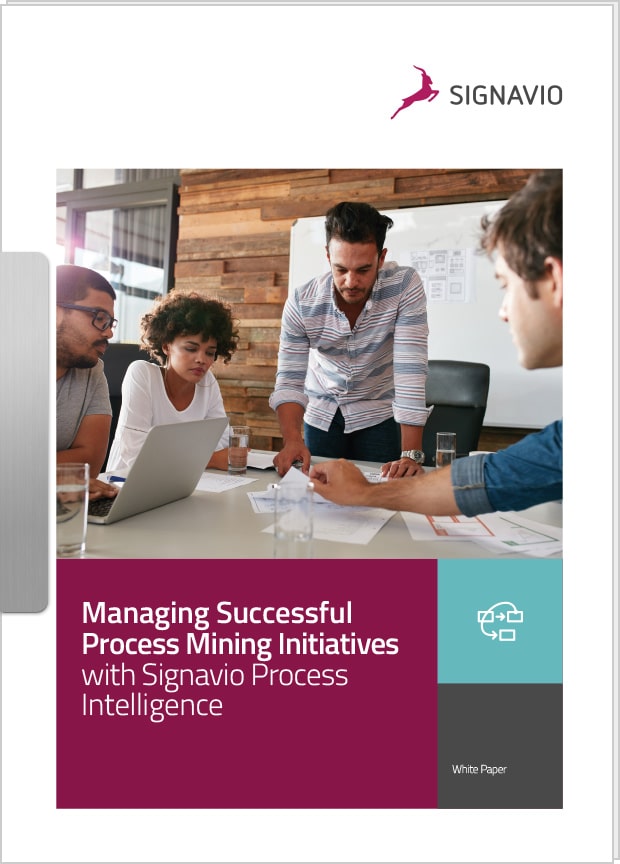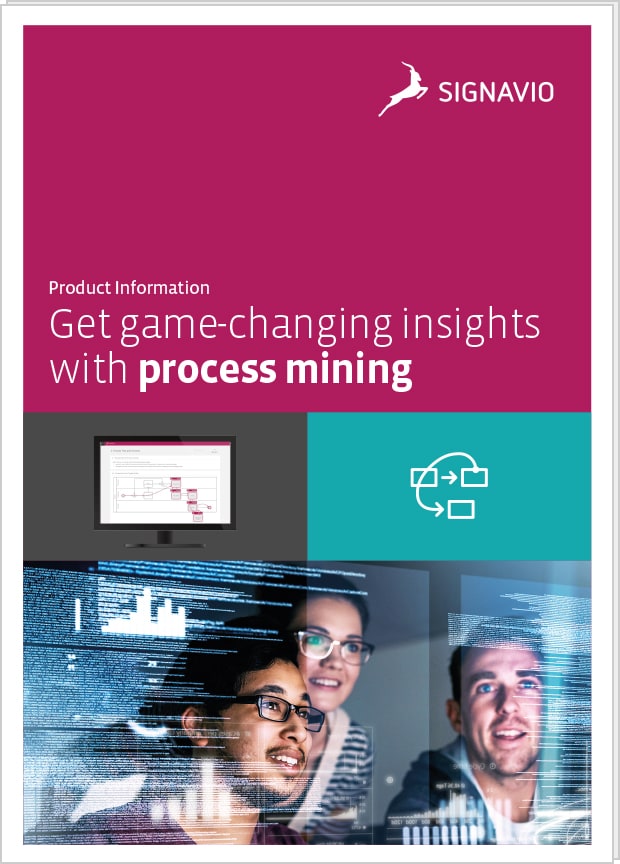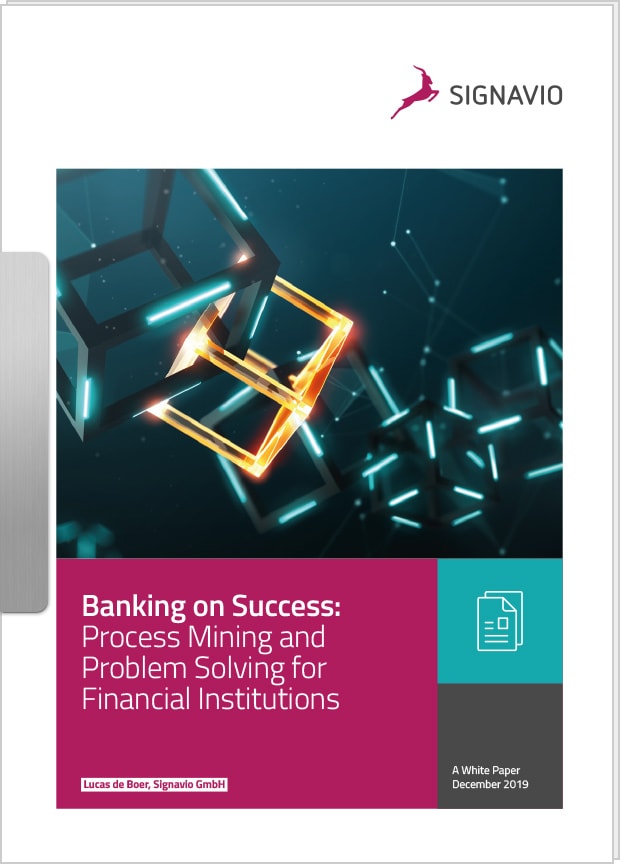Your Guide to the Power of Process Mining
- Definition of process mining
- Gain critical insights
- Benefits of process mining
- In practice, Process mining looks like
- Effective process mining
- Decrease incident resolution times
- Challenges of process mining
- Understand data before any critical changes
- Managing successful process mining initiatives
- How to optimize automation?
- The principles of process mining
- Let data tell your real story with Signavio
- Look beyond the tech horizon
- Signavio: your intelligent imperative
Definition of process mining
Every business is made up of processes. Some are exclusively carried out by human workers, some happen automatically, and many are a combination of the two. Almost all processes in a modern enterprise, however, are supported or enabled by software and IT systems, meaning they leave behind digital traces. Scanning the electronic event logs of your organization’s software and systems can help identify patterns and trends within those systems, and demonstrate the way your business actually works. 'Digging up' these event logs is more commonly known as process mining.
Gain critical insights
Process mining software enables organizations to run in-depth process analysis on their own event data, identifying the root causes of poorly performing processes, detecting and visualizing compliance violations, monitoring process performance, and supporting collaborative action on critical cases and performance bottlenecks. Process mining allows you to gain insight into your process operations without the money and time investment of typical data analytics projects. Many of the processes you seek to optimize, change or re-automate already exist in the systems you use. The faster you discover what you have, the quicker you can apply changes that make a difference in your business.
Benefits of process mining
In short, mining your business process data is a way of extracting insights into the way your business actually works, enabling you to drive digital transformation by improving the efficiency and effectiveness of business processes across your entire organization. You can think of process mining as the answer to the question, "Why are my processes not working like they should, and how can I make them better?"
In practice, Process mining looks like:
- Quick and easy process discovery, helping employees diagnose issues, make the best decisions, and put the right changes in place;
- Developing a constant, real-time narrative of operational health, process efficiency and process risk;
- Quickly identifying bottlenecks and performance issues, making for faster and more cost-effective troubleshooting;
- More robust risk and compliance systems, which can be automatically updated in the case of new regulations or requirements;
- Easier alignment between your underlying business processes and the demands/expectations of your customers;
- Consolidation of process data across multiple systems, ensuring a comprehensive view of your entire process landscape;
- The capacity to conduct end-to-end analysis of specific processes within your company; and
- Identification of processes suitable for robotic process automation, or other automation initiatives.
Effective process mining
An effective process mining project offers you and your colleagues an accurate picture of how your business is operating. Of course, even with this information, different staff members can have different views on the solution to a problem. It is therefore vital that a space is available for everyone to discuss the business processes discovered through process mining, and develop a plan for the application of any changes. Your goal should be to move as quickly as possible from identifying a problem, to implementing a collaborative solution. Instead of acting in isolation or based on instinct, process mining lets you create collaborative action plans which you can share with the rest of your team immediately, in real time.
To take one example, an area where process mining is already paying dividends is IT incident management. Here, “incident” is an unplanned interruption to an IT service, which may be complete unavailability or merely a reduction in quality. The incident management process aims to restore a normal service operation as quickly as possible, and to minimize the impact on business operations. Incident management is a critical process, and when an incident occurs, a response is often required from multiple staff members spread across multiple teams within a business.
Decrease incident resolution times
Process mining can drive improvement in “as-is” incident management process by increasing visibility and transparency across IT processes. Using event data gathered during the actual response to an incident, the analytics based on this process discovery lets you examine the different working habits across teams and individuals. (This is especially useful in detecting instances of non-conformance with official policies.) Your analysis can then lead to recommendations to decrease incident resolution times and subsequently reduce the impact of IT incidents on customers and the organization's normal functions.
Once you have fixed critical causes for bottlenecks, unnecessary costs and risks, you can move on to addressing issues of lesser importance that still create significant costs, or keep you from further increasing your revenue. Process mining analytics can be used in an iterative way, helping you to build more and more detailed records of your business data, thus ensuring you are able to identify future issues quickly and respond immediately. In this way, process mining becomes a source of continuous process improvement, instead of a time-limited or one-off project.
Challenges of process mining
Process mining software is an excellent way to carry out analysis of your organizational event logs, examine every process model in detail, and ensure conformance and compliance by identifying variations between each process model and the way it functions in reality. However, one of the key challenges to process mining software is right there in the name: software. A process mining tool is limited to investigating information systems - software cannot "see" or address aspects of a business process that take place in real life.
In much the same way, the application of process mining as a pure technology cannot leverage human understanding. Combining facts with feelings remains a uniquely human skill, which software cannot (yet) replicate. This mix is necessary for a complete understanding of not only the structure of a process, but also its actual purpose - which may not always be the same as its function! Take a simple approval workflow as an example. The structure of the process may simply ask for one or more employees to acknowledge receipt of a specific notification, whereas the purpose is actually accountability, via creating a record of who acknowledged the notification and when.
Understand data before any critical changes
Application of knowledge also represents the most significant gap between successful process mining initiatives, and those with less-than-impressive implementation. Choosing the right set of process mining techniques is only the beginning of a successful project. Those overseeing such projects must understand what the data is saying, before attempting to make changes. After all, data mining of process maps and event logs can only tell you so much. Knowing what you have is only half the story; knowing why it happens and what to do about it is what counts.
The solution to these challenges is to combine process mining techniques with a broader commitment to business process management (BPM). Transformational change cannot occur without a foundation of strong business knowledge, while strong business knowledge must be supported by technical expertise, which informs the accumulation of further knowledge, and so on. This self-sustaining approach to business process management leverages the wisdom of the crowd to build a process culture within an organization, in turn leading to truly sustainable outcomes across the entire enterprise.
Managing successful process mining initiatives
At its best, process mining builds a bridge between employees, business process experts and management. This helps avoid siloed thinking, as well as enabling transparent design of handovers and process steps which cross departmental boundaries within an organization. Harmonizing processes from fragmented sectors and regional locations is vital to a cohesive approach to work for any organization. Achieving this goal requires data sets and statistics from the actual processes involved, rather than relying on the instincts and estimations of individuals.
How to optimize automation?
To optimize your process landscape, keep it functioning at a high level long-term, and avoid repeating process mistakes, your objective should be to understand how your processes are really being carried out. A process mining solution is the best way to help you achieve this, removing the need for costly and time-consuming external analyses, with the increased likelihood of human error. Instead, modern process mining tools allow you to launch automated analyses of your process data by yourself, whenever you want.
With this, however, comes the importance of ensuring you are managing your process mining initiative in a way that enhances the probability of success. Keeping the following principles in mind should set you on the right path.
The principles of process mining
- Define and share a clear goal - Regardless of whether your initiative is a company-wide project or just a small pilot, it must have a clear rationale and reason for taking place, as well as defined and measurable criteria outlining what counts as "success."
- Start small and build up - Starting with a manageable part of the overall process landscape avoids long projects and ensures quick results. For best results, the process you choose should be a clearly defined part of your organization’s core business, that is simple but executed frequently. (Procurement, customer support, logistics, or sales processes often work well.) Once a first process (or part of a process) is analyzed and first insights are gained, the process can be enhanced with more detail, or a different start or end point, and further processes can be analyzed.
- Involve the right people at the right time - A crucial key to success is making sure you involve the right people. This may be at different stages for different people, and almost certainly will mean different levels of engagement, but they should share a common commitment to the project, and therefore be supportive of the project's goals.
- Communicate and collaborate - Some staff may hold specialized technical knowledge of particular processes within your organization. Equally, other staff from entirely different business areas may interact with a given process in a very different way, and therefore have a unique perspective on how the process model could be improved. Bringing these groups together depends on a common, discussion-based interpretation of the current process model, including process flow and variations in elements of the process. Any corrective actions taken as a result of the project should also be based on a collaborative solution.
- Take action and measure results - All data sets and findings about processes are interesting to someone. (Well, almost all...) However, unless they are interpreted and given meaning, the result is simply information. It is the actions defined and undertaken based on those insights that give meaning to the analysis. After the actions have been implemented, the effect can be measured by analyzing and monitoring the process again, so the effects of the actions can be refined or replicated as necessary.
Let data tell your real story with Signavio
Over the past few years, the quality of discussion regarding a ‘process’ and its interfaces between different departments has radically developed. Organizations increasingly reject guesswork, individual assessments, or blame-shifting and instead focus on the objective display of throughput times, process variants and their optimization. They know BPM is the secret to reducing inefficiency, streamlining conformance checking, and improving processes; the next step is the right software to support continuous process improvement.
Look beyond the tech horizon
With SAP Signavio Process Intelligence, you can make better decisions faster. The powerful combination of process discovery, process analysis and conformance checking with a customizable ETL engine supports a collaborative approach to process improvement, without the burden of clunky on-premise tech. By data mining your organization’s IT systems, SAP Signavio Process Intelligence will give you game-changing actionable insights into the way your business works, meaning you can pinpoint opportunities for improvement.
Signavio: your intelligent imperative
Get a complete end-to-end perspective on exactly what is happening in your organization in a matter of weeks, with SAP Signavio Process Intelligence. To find out more, or see how Signavio can help you conduct powerful fact-based analysis across your whole organization, why not sign up for a free 30-day trial today.










